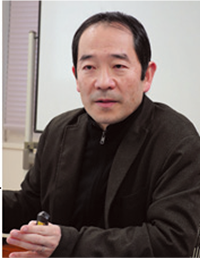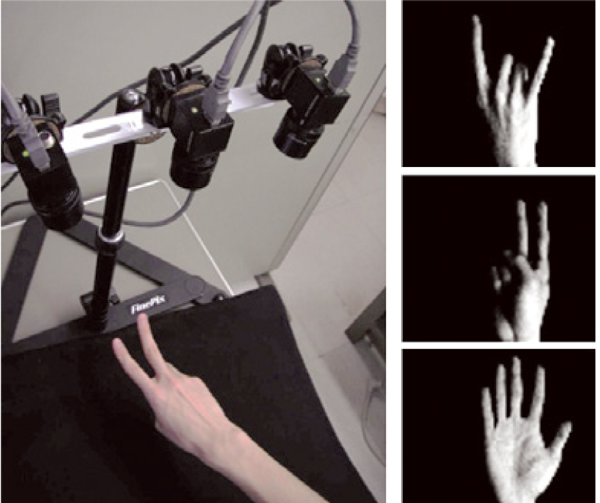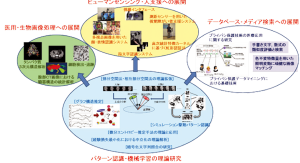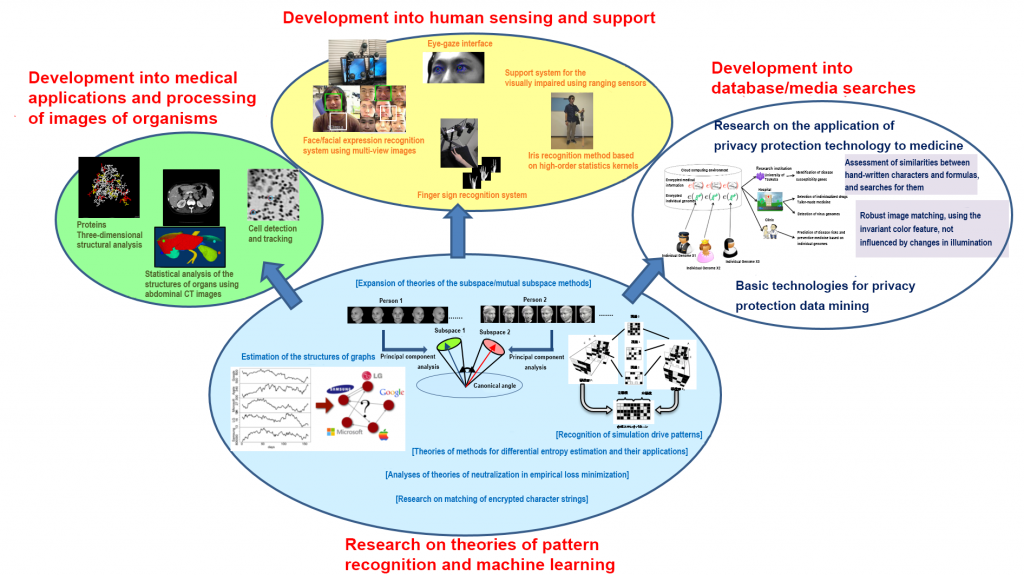キーワード: パターン認識、画像認識、機械学習、統計科学、ビッグデータ
http://www.cvlab.cs.tsukuba.ac.jp/~prml/

人を支える様々な知的システムの高性能化や、ビッグデータの出現に伴い、近年、社会の様々な場面で、膨大なデータを用いて柔軟で複雑な判断をするコンピュータが求められています。パターン認識は、コンピュータが入力された情報の特徴をデータベースと照合する際に使われる技術です。また、こうした照合の積み重ねによって独自にデータベースを更新していくことを機械学習といいます。これらの技術によって、人間が経験を活かして物事を判断するように、コンピュータも判断や学習ができるようになります。しかしデータ量が多くなると、コンピュータの計算処理時間が増え、実用レベルではなくなってしまいます。この問題を解決するため、本リサーチユニットでは統計学など数学を駆使して、パターン認識と機械学習の精度向上に向けた理論と基盤技術の研究開発を進めています。
指文字学習支援システム

図1:指文字認識システム。複数台のカメラで撮影した画像を、様々な指文字と照合する
リサーチユニットの研究成果の一例として、指文字学習支援システムを紹介しましょう。指文字は、手の形で50 音の各文字を表現する視覚言語の一つです。人差し指と中指を揃えて伸ばす、離して伸ばす、などの良く似た形が違う音を表すこともあります。指文字の学習者にとっては、自身の指文字が相手に通じる正しい「形」になっているかどうかを判断してフィードバックしてくれる機械が存在すれば、効果的に学習を進めることができます。しかし、見る角度によっては同じに見えてしまうような形もあり、二次元的な形の比較だけでは精度面で実用に耐えるものにはなりません。
本リサーチユニットでは、複数台のカメラを用いて学習者の指文字を撮影し、データベースにもさまざまな角度から撮影した複数画像を用いることで、精度の高い指文字学習システムを開発しました(図1)。データ量の増加に対応するために、相互部分空間法*1 という識別法を用いて識別処理の効率化を実現しています。
医学・セキュリティ・さまざまなフィールドへ

図2:リサーチユニットの研究分野
他にも、本リサーチユニットではさまざまな視点からパターン認識技術の実用研究を進めています。例えば、検体の中から特定の細胞を検出する技術や、CT 画像から臓器の病変を認識し医師の判断をサポートする技術など、医学分野への応用研究も行っています。 また、パターン認識技術の応用先は画像処理だけではありません。情報を暗号化したままで内容を照合する秘密検索手法の開発にも取り組んでいます。
こうした異なる課題に取り組む研究者同士が相互に情報交流することで、新しいパターン認識の理論体系の創出を目指して研究を推進しています(図2)。
*1:相互部分空間法では、一枚の画像を高次元ベクトル空間の一つのベクトルと見なし、比較する2つの画像セットをそれぞれベクトル空間における部分空間でコンパクトに表します。これにより2つの画像セットの類似度を部分空間の距離として効率良く求めて、安定な識別を実現しています。
社会への貢献・実績
- プライバシ保護技術の医療応用に関する研究を実施
- 画像センサを用いた視覚障がい者支援システムの研究開発を実施
- 腹部X 線CT 画像からの対話的な臓器抽出手法の研究開発を実施
- タンパク質の構造解析のためのマルチモーダル構造類似度の研究開発を実施
取材:平成27年2月18日
To achieve a breakthrough for the development of basic technologies to support society
Unit members : Kameyama, Keisuke Sakuma, Jun Takizawa Hotaka Suzuki, Kenji
Unit name: Pattern Recognition and Machine Learning
Keywords: pattern recognition, image recognition, machine learning, statistical science, big data
In recent years, as intelligent systems helping people  become more sophisticated and as more big data became available, there has been an increasing demand for computers that make flexible and complex judgments based on the big data in various situations in the society. Pattern recognition is a technology to match the characteristics of input information with those in the database. Machine learning is a technology to continually update the database with the input information autonomously. These technologies enable computers to be trained to make decisions, just as humans decide things based on their own experiences. However, such a machine learning becomes impractically slow as the computational time grows with as the size of the data.
become more sophisticated and as more big data became available, there has been an increasing demand for computers that make flexible and complex judgments based on the big data in various situations in the society. Pattern recognition is a technology to match the characteristics of input information with those in the database. Machine learning is a technology to continually update the database with the input information autonomously. These technologies enable computers to be trained to make decisions, just as humans decide things based on their own experiences. However, such a machine learning becomes impractically slow as the computational time grows with as the size of the data.
To address this problem, the research unit uses mathematics such as statistics to develop the theory and the technology to improve the accuracy of the pattern cognition and machine learning.
Learning support system using finger signs

Figure 1: Finger sign identification system. Matching of photographs taken by multiple cameras with different finger signs
As a good example of our researches, we show you a learning support system for a finger alphabets which is a visual language system to express the 50-character Japanese syllabary with finger shapes. Similar finger shapes sometimes represent two different syllabary characters. For example, a pair of straightened index and middle fingers mean different syllabary characters depending whether the two fingers are sticking each other or not.
If there is a machine that tells a finger-alphabet learner whether or not a particular finger shape is correctly understood by another person, the learner can learn the skill efficiently. However, since finger shapes can look similar from some angle, two-dimensional information is not enough to give a useful feedback signal for a practical level of precision.
Therefore, the research unit developed a highly accurate learning system for finger-alphabet learners, which uses multiple cameras (Figure 1) to acquire views from different angles, which also uses the database containing photographs of finger shapes taken from different angles. To overcome an increased computational load due to the growing size of data, the system employs a method referred to as the Mutual Subspace Method.*1
Applications to medicine, security, and many other fields

Figure 2: Fields of research conducted by the research unit
The research unit conducts other researches on practical applications of the pattern recognition technologies from various perspectives. Technologies that the research unit pursue include ones in the field of medicine, such as a technology to identify specific cells in specimens and a technology to find abnormality in an organ with its CT images to help physicians diagnose.
Our pattern recognition researches are not limited to the image processing. The research unit develops a method of identifying two pieces of encrypted information without deciphering them.
Researchers involved in studies on a variety of different subjects exchange ideas with each other on a routine basis to find out new theoretical systems for the pattern recognition (Figure 2).
*1Mutual Subspace Method represents a visual image with a high dimensional vector, and makes an efficient comparison between different visual images in a compact subspace with a similarity measure (a distance in a subspace), enabling a robust comparison.
Social contributions and achievements
- Research on the application of privacy-protection technologies to medicine
- Research and development of systems for supporting visually-impaired people using image sensors
- Research and development of interactive methods for the excision of organs using abdominal X-ray CT images
- Research and development of the similarities of multimodal structures to analyze the structures of proteins
Interviewed on February 18, 2015
